Why 1.5oC is far too much for some
Hector McNeill1
SEEL
 Most economic analyses related to climate change base their models on climatic data and trends in such variables as average temperatures. This is neat for mathematical models which attempt to simulate what will happen in the future as a basis for determining what is and is not tolerable in terms of economic consequences.
Most economic analyses related to climate change base their models on climatic data and trends in such variables as average temperatures. This is neat for mathematical models which attempt to simulate what will happen in the future as a basis for determining what is and is not tolerable in terms of economic consequences.
This sort of nonsense lacks raw knowledge of what is in fact happening "on the ground" where it is not climatic averages that are the problem. The problem is the meteorological conditions around these "climatic" averages.
|
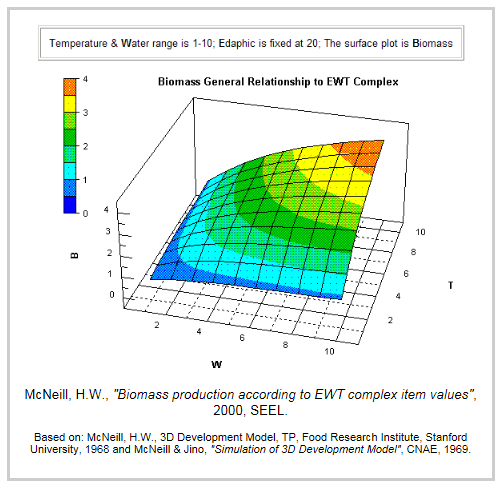
I have been involved in agricultural development for around 50 odd years including a good deal of field work largely in Brazil, Peru and Africa, and as an economist have become increasingly dismayed at the errors contained in economic models linked to climate change. I might be wrong, but most models I have had time to look at, base projections on climatic data.
However, as farmers and communities worldwide will tell economists, although average climatic conditions are important, the damage is already being wrought by meteorological conditions. In other words the seasonal variations of conditions, around the average, are already disrupting production and the livelihoods of communities.
I have also worked on techniques to improve the quality of information used for modeling this reality based on location-state theory
2, an approach initiated at ITTTF
3 in 1985. Since this was 35 years ago what is stated here is nothing particularly original but it is constantly overlooked in forums and seminars on this topic.

Coffea arabica spp.
Inflorescence |
By way of illustration locational-state analysis of crop or biomass production (B) in kg./ha. is related in basic terms to water availability (W), temperature regimes (T) and soil texture and fertility (E for edaphic). There is a direct relationship between these variables and yields as illustrated in the 3-D projection shown on the right.
A case in point - Coffea arabica spp.
Frost in the State of Parana in Southern Brazil, a major coffee producing area, was occurring on average every 4 years in the areas south of the 23rd parallel South during the period 1965 through 1995. This resulted in falls in yields of coffee in the following years. At the time Brazil produced 60% of the world coffee production so this was a serious issue given the inelasticity of demand for coffee generating significant price rises and market instability.
Therefore, coffee production was moved to bioclimatic zones further North and closer to the Equator, with less frost incidence. However, with global warming, for example in lower altitude regions of North East São Paulo State, farmers experienced a period during which coffee yields began to fall quite dramatically. The farms experiencing this evolution were applying their variable inputs as recommended and the varieties were adapted to the region (based on agroecological zoning (AEZ)) and as recommended by the best current professional advice via extension. However, the reason for the dramatic fall in yields was climate change-related rises in ambient temperature. In the coffee plant flowering period, which starts around April to flower maturity in around June in the Southern Hemisphere, the ambient temperature, on occasions, had exceeded 33
oC.
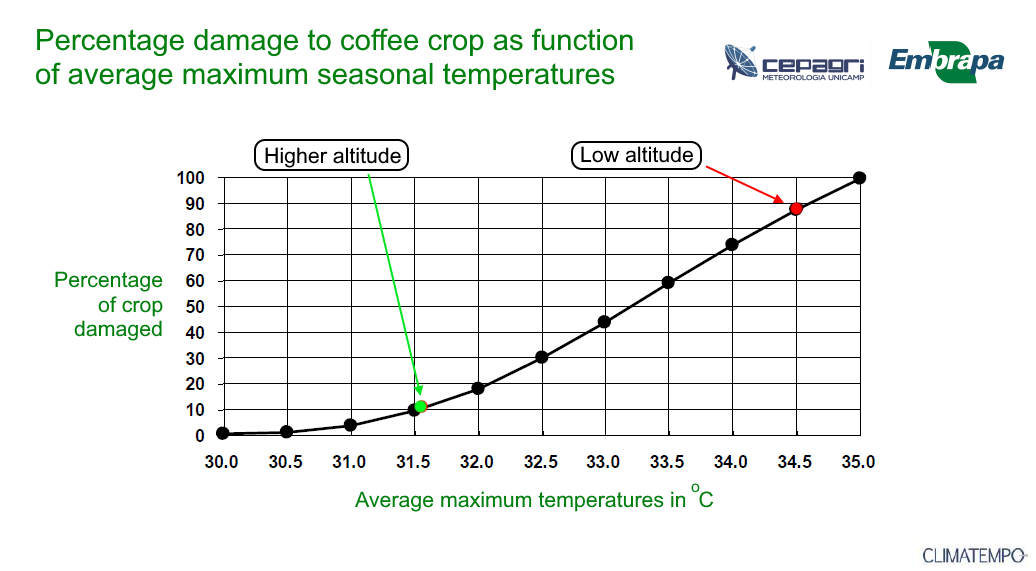
The association of coffee crop damage with temperature from: Pinto, H. S., "AgroTalk - The Brazilian agriculture zone", CEPAGRI, EMBRAPA |
This temperature is fatal for the coffee flowers which are extremely delicate. As a result, there was no pollination or fruit formation (berry) and therefore no production of green berries or only a very low yields gathered from plants at higher altitudes and which had not been exposed to the 33
oC temperature.
There is a well-established relationship between altitude and temperatures with ambient temperatures falling by approximately 0.6
oC for every 100 metres gain in altitude. As a result, coffee production migrated to cooler higher altitudes in the State of Minas Gerais.
In the meantime, where frost had been occurring in Parana State in the past, for the last 15 years, there have been no frosts as a result of global warming. Some coffee production has returned to that State.
In its basic form we are interested in "sustainability" in the sense of the renewable natural resources of the planet not being overwhelmed by the increasing consumption levels of a rising human population and the use of inappropriate technologies used to produce basic human needs.
Climatic averages and meteorological variance Folllowing the trend line for the climatic average temperature CT-CT usually ignores the season variations dues to meteorologial conditions which can be 5oC higher (MMax) or lower (MMin) than the average in some years.
As a result damage to crops and loss of water in those particular years can and do results in production failures 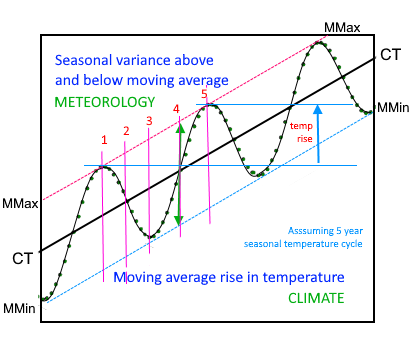
Global Constraints Analysis, SDGToolkit Manual, V.1.3, 2021
Based on current draft of: McNeill, H. W., " The significance of an extended farm typology for agricultural sustainability", Part 6 of the series: "Economic Policies for Agenda 2030", Agricultural Innovation, March 2021, APEurope. |
|
|
The leading edge of the impacts of increasing climate change prejudice is the rise in temperatures regimes associated with seasons with above average temperatures. For example in the 4-5 year cycles in seasonal associations of different temperature and water regimes, the warmer occasions are the most destructive because these can result in the ambient temperature rising by up to 5
oC above the average. Therefore in the case of the example of coffee flower destruction, this would have been initiated in a warmer seasonal variance year where coffee yields would have suffered but in the following years the temperature could be even less than average but in subsequent years the temperature rises would be correspondingly at a higher level affecting more of the crop and becoming more noticeable.
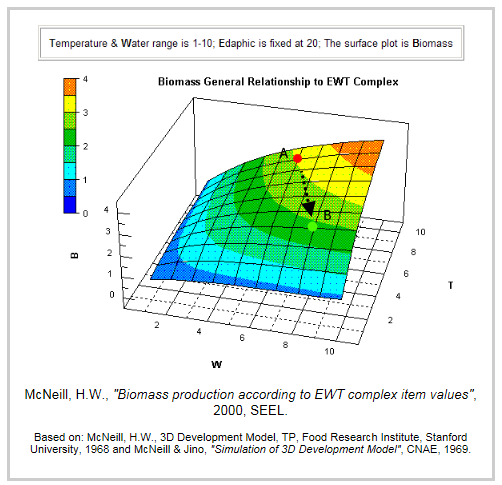
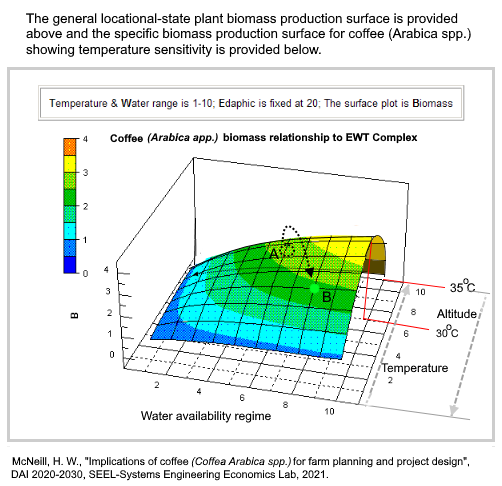 |
It is very apparent that the model admittedly produced 53 years ago and based on climatic averages needs to be "read" as a "real time" display. In other words the degree of reliability on climatic averages and therefore stability of the model needs to be replaced with an awareness that average conditions almost never exist due to meteorological variance around the "average". Therefore the determination of risk to farmers needs to build in normal variance of conditions due to seasonal meteorological variance. The theoretical depiction of the shift to cooler areas is shown on the right by the transition from point A to B. However, the reality of the production surface in hot seasons is shown below that diagram on the right where point A is associated with close to zero production in seasons with higher temperatures but the point B is safely within a level of low damage resulting in economic production.
As can be seen from this snapshot the projections based on average climatic conditions are misleading and provide a picture of a 1.5
oC rise in average temperatures not being of much consequence. This is completely wrong and dangerously misleading leading to government strategies and development agencies underestimating the current state of affairs and talking about planning horizons that can even reach 2050, 2040 or even 2030. The time for action is now, so, don't let economists tell you otherwise. The typical attendant issues with the years experiencing a variance into higher temperature levels is that evapotranspiration also rises so that thousands of additional cubic metres of water enter the atmosphere leading to larger volumes of downpours causing additional damage in the form of mud slides, soil erosion and other forms of destruction on an accelerating basis impacting, usually, low income communities.
The cumulative impact of MMax data on project cash flows according to types of impact:
- Presumption of no impact F1;
- Impact of rising water deficit F2;
- Reproductive disruption F3
. 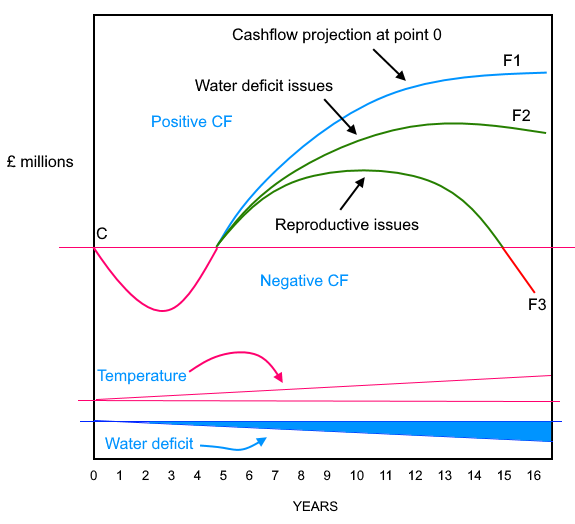
McNeill, H. W., "Implications of CEPAGRI data for future proposal appraisals and evaluation methods", DAI 2020-2030, SEEL, January, 2021. |
ConcludingEconomic models need to embed realistic risk analysis which brings into focus meteorological variance. The implications for agricultural investment project design for private donors and international development agencies as well as agricultural communities is massive. Most current project design procedures are totally inadequate as are the standard procedures for project appraisal applied by such organizations as the World Bank. Just in the case of coffee reviewed in this article which is one of literally thousands of commodities shows that financial projections need to be adjusted to reality because quantifiable impacts will occur within the life time of project cycles.
The George Boole Foundation's successful Decision Analysis Initiative has studied this issue since 2010 within the Open Quality Standards Initiative operations and has been extended to 2030 in order to continue the development of improved appraisal techniques. The diagram on the left compares the common cash flow projection based on standard procedures (F1). The second shows the impact of loss of water due to higher evapotranspiration because of rising temperatures leaving less available for crops in rain fed agriculture (F2). In the case of coffee with reproductive impairment as described above, the fall in cash flow is even more dramatic as shown in projection F3.
Sadly to say this results in a lot of what economists have been taught on project evaluation and investment appraisal in agriculture not being very useful. The World Bank's standard reference on agricultural project design, "Economic Analysis of Agricultural Projects" by J. Price Gittinger contains nothing to help economists adjust data to the reality facing us. Most guidelines on project cycle management circulating in the leading development agencies have not yet been brought up to date.
We have gained enormously by basing work on a systems engineering approach and have involved stakeholders at all stages of this development work.
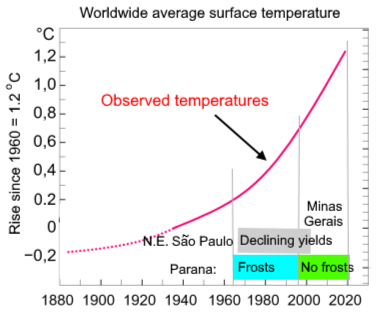
Many necessary advances have been introduced by the team developing the SDGToolkit at SEEL which has faced development delays due to third party licensing arrangements last year but this was resolved by bringing all software development in-house so there is no further reliance of third parties.
Further information on this system will be provided as the system readies for release in the next couple of months.
Lack of coherence in climate objectives from the standpoint of world agricultureThe title of this article refers to one and a half degrees which is lower than the range set by climate experts and scientists (2
oC) and by some economists (4
oC) such as William Nordhaus
4. The disruption caused to Brazilian coffee production recounted in this article occurred as a result of average temperatures, rising by around 1
oC. What is apparent, is that in these academic and joint studies, there is very little reference to meteorlogical variance and Nordhause's work does not even refer to agriculture at all.
Based on the 1.5
oC projections it is expected that Brazil could have 10.6 million hectares less land allocated to agriculture in 2030 as a result of climate change with the South Region being the worst impacted losing close to 5 million ha by 2030
5.
The reality is that with just 1
oC rise considerable disruption has occurred and so far the actual damage to crops and food production has not yet been fully calculated because variance due to meterological conditions appears to be overlooked.
1 Hector McNeill is the Director of SEEL-Systems Engineering Economics Lab.
2 Locational state theory is a generic theory of systems and has important contributions to improving the identification of core data requirements for advanced IT and AI applications.
3 The ITTTF - Information Technology & Telecommunications Task Force was a strategic planning group at the European Commission. It ran the DELTA programme headed by H. McNeill between 1984-1987 and the Tempo initiative focusing on AI, global communications systems applications development. Topics reviewed including conceptual designs included hand help computer telephone (iPhone), radio-based networked global communications system very similar to W3, learning systems based on search and knowledge dissemination and spin offs including
Accumulogs and locational-state theory.)
4 Nordhaus, W.,
"Projections and Uncertainties about Climate Change in an Era of Minimal Climate Policies", American Economic Journal: Economic Policy, vol. 10, no. 3, August 2018, (pp. 333-60)
5 Pinto, H. S.,
"AgroTalk - The Brazilian agriculture zone", CEPAGRI, EMBRAPA.
All content on this site is subject to Copyright
All copyright is held by © Hector Wetherell McNeill (1975-2021) unless otherwise indicated